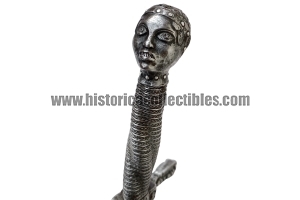Forged iron dagger, carved and engraved called "Moor's Head", Northern Italy, 1600-1620
Forged iron dagger, dating back to the first half of the 17th century, with a double-edged blade, straight hilt with rich high-relief decoration depicting caryatids and central masks carved and meticulously engraved. The handle, with a singular twisted shape, is finished with steel wire woven along its entire length and supports the pommel, embossed with a burin, to depict the head of a Moor decorated with embedded silver beads.
It was around 1600 in fact that the "fashion" of decorating the handles of cutting weapons with African heads was born in northern Italy. Renaissance exploration and colonization in Africa and the New World aroused a growing interest in the exotic style, especially in Milan and in the territories of the Republic of Venice.
Furthermore, Moor's heads refer to the heraldic images of the heads of Africans represented on coats of arm, crest and flag found throughout Europe (1300s AD - present). Despite the common misconception that Moor's heads are representations of unknown Muslims defeated in battle, evidence suggests most know Moor's heads are representations of specific Africans in honor of their contributions to Catholics in Europe.
Its original rounded scabbard is made of forged iron sheet masterfully embossed with decorative figures of soldiers and animals, crumpled, brazed in brass and closed at the end by an engraved hemisphere.
This stiletto, certainly intended for high-ranking noble commissions, can be attributed to craftsmen active in Milan or Venice.
Excellent condition of conservation.
Reference:
Kunst Historisches Museum Wien - Inv. Nr. Hofjagd- und Rüstkammer, A 1029 (https://www.khm.at/objektdb/detail/371394/?pid=251...)
Decorative Antique Ironwork: A Pictorical Treasure (Henry Renè) - Pag. 387
http://www.taneter.org/moorsheads.html



